Dedicated surveys to describe the distribution and abundance of a remnant cisco population in Green Bay
Contributing Authors
Dale Hanson (USFWS, dale_hanson@fws.gov), Ted Treska (USFWS)
Executive Summary
Contemporary spawning of cisco and lake whitefish is not known to occur in southern Green Bay but in recent years a small number (< 10 per year) of cisco adults have been recovered along the Door Peninsula, and lake whitefish larvae have been captured in drift sampling outside of the Sturgeon Bay Canal. We used diurnal hydroacoustic sampling (120 kHz 7-degree split-beam transducer) with a minimum integration threshold of -44.5 dB to measure the nautical area backscattering coefficient (NASC) of fish targets larger than 215 mm along the 10 – 15 m contours of the Door Peninsula. This was done to identify locations with higher densities of potential coregonid targets (e.g. spawning aggregations) in late October and early November, given spawning times observed by other cisco efforts in northern Lake Huron. The greatest fish target densities were observed southwest of the Sturgeon Bay Canal (Larsen’s Reef area) and northeast of the Canal (Little Harbor). In areas with elevated NASC (fish back-scatter), we used short-duration bottom and suspended gill net sets (300’ panels 4.5” monofilament mesh) to validate species composition. These 3 - 8 hour sets resulted in the capture of pre-spawn lake whitefish but no cisco were caught; some nets also contained substantive bycatch of smallmouth bass, walleye, white sucker, and common carp. We subsequently returned to a suspected lake whitefish spawning area near Larsen’s Reef on November 18th and set overnight suspended gill nets at bottom depths of 6 – 9 m; catch included two ripe females, in addition to many ripe males and spent females. Finally, on November 26th divers returned to the nearshore Larsen’s Reef area to confirm lake whitefish egg deposition; however no eggs were recovered. Therefore this survey provides evidence that lake whitefish are spawning near the Larsen’s Reef area and represent the likely source of larval lake whitefish recoveries near the canal, however the specific habitats selected by spawners remains unknown. Genetic tissues from the spawning condition lake whitefish (nets lifted on Nov. 19th) were provided to the UW-Stevens Point genetics lab for inclusion in lake-wide analysis of lake whitefish stock delineations; preliminary results suggest these fish, and those spawning within west-shore tributaries of Green Bay, represent a distinct Southern Green Bay stock (Wes Larsen, unpublished data).
